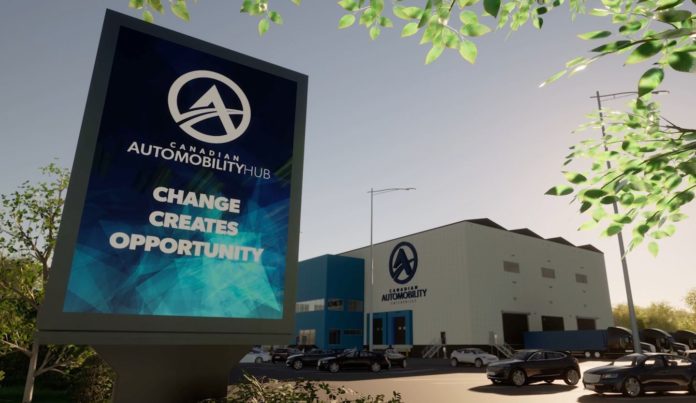When a vital industry in a local economy faces disruptive change, there are two choices: lead the transformation or fall victim to it.
Windsor-Essex is leading the way in the historic shift from the production of vehicles powered by the internal combustion engine to the electric – and connected – vehicle of the future.
The economic development team at Invest WindsorEssex (IWE) began work on an automobility strategy more than four years ago with partners from industry and post-secondary institutions.
Since the arrival of Ford in 1904 and bolstered by the arrival of Chrysler’s assembly plant in 1928, Windsor has been known as the automotive capital of Canada. Building on its rich history in advanced manufacturing, the region has always embraced innovation and technology advancement in the automotive sector. It has now emerged as the automobility capital of Canada: a leader in next-generation vehicle production.
Windsor-Essex is home to more than 1,000 manufacturers, 450 automation firms, and 350 parts, machine, tool, die and mold companies that together fuel the auto production industry.
That sector strength has led to the region’s leadership in innovation and research in each of the four pillars that underpin automobility: connected, autonomous, secure and electrified vehicles.
The Automobility and Innovation Centre was established in 2017 as one of five departments within IWE. It is tasked with supporting local industry in making the shift to next-generation mobility production.
“I’m not aware of any other region that has done something like this,” says Matthew Johnson, executive director of mobility partnerships and innovation with IWE. “It is true collaborative economic development that comes out of a strategic vision and a determination to lead the automotive transition as the automobility capital of Canada.”
With a $5 million grant from the Federal Economic Development Agency for Southern Ontario (FedDev Ontario) in 2019 came the founding of the Canadian Automobility Hub in late 2021, which is a network of partners, including the University of Windsor, St. Clair College, IWE, and private companies that provide wraparound services to companies that are scaling and growing production in Windsor-Essex.
The hub includes a research centre at St. Clair College and a micro-production facility led by a private-sector partnership.
The hub was founded on the recognition of Windsor’s deep experience and expertise in the auto sector. Government funding has leveraged about $12 million in investment in the hub from the private sector.
“That is a clear indication to us that industry sees the value in investing in this and working together to realize an automobility future,” says Johnson. “It’s difficult to accept change and disruption, but there is recognition that there are huge opportunities ahead.”
The hub also provides companies access to the IWE VR CAVE, which offers a virtual testing and simulation environment for connected and autonomous vehicles (CAV).
“It’s built around state-of-the-art hardware and software,” says Ed Dawson, senior manager of automobility and innovation with IWE. “The CAVE has been a very important piece of the work that we do. It’s Canada’s largest publicly accessible VR environment for CAV technology development.”
As a binational region, Windsor-Essex’s research niche is the border. The VR CAVE works in conjunction with smart traffic equipment along the trade corridor to test new technology and simulate operations.
“It is not a simple process to test new technology at the border. In fact, safety, security and privacy concerns means physical testing may not happen very quickly,” says Dawson.
But through the creation of a newly unveiled digital test track of the border crossing at the Windsor-Detroit Tunnel, innovators can test sensors and visioning systems and run scenarios.
“It’s easy, safe and requires no government approvals. This work is a stepping-stone to providing a proof of concept with the hope of one day pitching to governments and border agencies to do a live pilot.”
In late 2021, FedDev Ontario invested another $7.5 million to support the work of the partnerships within the Canadian Automobility Hub. The province has also invested $2.5 million since 2019.
A key partner in the hub is St. Clair College.
“I see a growing role for St. Clair,” says Peter Wawrow, director of research and innovation. “We are making connections with new players in the region, especially in the area of battery production. We are building new curriculum to support that industry. And our students are engaged in research and experiential learning.”
Wawrow says the approach to building an ecosystem to nurture and grow the automobility sector will result in a “spinoff effect” to other industries because that model can used again.
“Great ideas spin off great ideas. This will be a catalyst for sure.”
Another key player in the hub is Automobility Enterprises Group (AEG), a private-sector partnership led by Germany-based PEM Motion that is establishing an EV ramp-up manufacturing facility in Windsor.
Its first project is the conversion of an ENWIN Utilities fleet pickup truck to electric power.
ENWIN is thrilled to be an initial client at AEG, says Barry Leavitt, director of corporate operations and innovation.
The utility intends to use its converted truck as a demonstrator for customers after consulting with fleet operators last year and finding concerns about the cost, maintenance, safety and reliability of an electrified fleet.
“We will collect data and user experiences about its performance so that when it comes time to buy new vehicles, there will better understanding of needs.”
Leavitt says he’s been impressed with AEG and with the collaboration that’s leading the Canadian Automobility Hub.
“The need to redefine yourself as the market evolves is essential. That’s what this region is doing. As we address climate change and our dependence on fossil fuel, we need to turn to new technology to maintain the mobility we enjoy.”
For more information visit canadianautomobilityhub.com
















